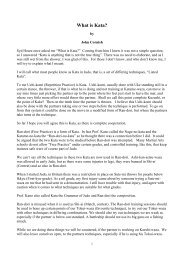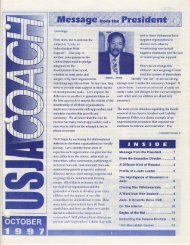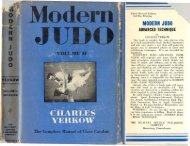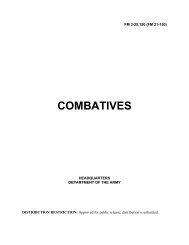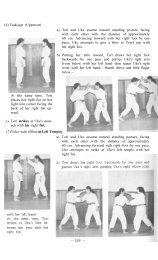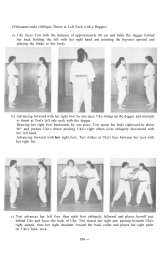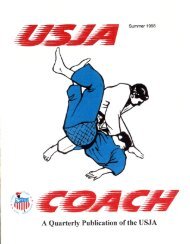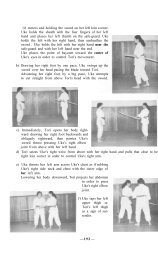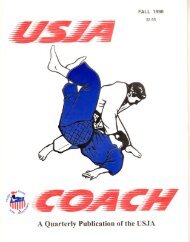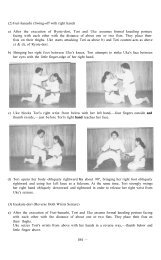Go-no-Kata: The Kata of the Force by Gianna Giraldi
Go-no-Kata: The Kata of the Force by Gianna Giraldi
Go-no-Kata: The Kata of the Force by Gianna Giraldi
Create successful ePaper yourself
Turn your PDF publications into a flip-book with our unique Google optimized e-Paper software.
<strong>Go</strong>-<strong>no</strong>-<strong>Kata</strong>: <strong>The</strong> <strong>Kata</strong> <strong>of</strong> <strong>the</strong> <strong>Force</strong><br />
<strong>by</strong><br />
<strong>Gianna</strong> <strong>Giraldi</strong><br />
(Translated: Dr Llyr Jones, 13 April 2007)<br />
<strong>Go</strong>-<strong>no</strong>-<strong>Kata</strong><br />
<strong>The</strong> traditional means <strong>of</strong> instruction within Budo disciplines is via exercises<br />
called <strong>Kata</strong>. <strong>The</strong> exception to this practice is Aikido, since its founder did <strong>no</strong>t<br />
want to create and define exercises for its study, even if some masters <strong>of</strong> <strong>the</strong><br />
art (for example Tomiki Kenji) later created some <strong>Kata</strong> in order to facilitate<br />
learning. All styles <strong>of</strong> Jujitsu have as <strong>the</strong>ir foundation <strong>the</strong> study <strong>of</strong> <strong>Kata</strong>, and<br />
every school has in its own traditional formal exercises in order to allow its<br />
study and transmission. Judo, being a direct descendant from traditional<br />
Jujitsu, has maintained this custom, and in its conception, particular attention<br />
was given to <strong>the</strong> preservation <strong>of</strong> several practical <strong>Kata</strong>. In <strong>the</strong> history <strong>of</strong> Judo<br />
several kata have been created - some <strong>of</strong> which have remained without<br />
modification whilst o<strong>the</strong>rs have been significantly changed over time. As an<br />
example, both <strong>the</strong> Nage-<strong>no</strong>- and <strong>the</strong> Ju-<strong>no</strong>- <strong>Kata</strong> were originally were<br />
composed <strong>of</strong> ten techniques, to which were five o<strong>the</strong>rs were successively<br />
added. <strong>The</strong> Koshiki-<strong>no</strong>-<strong>Kata</strong> is preserved in Judo as an exercise from Kito Ryu<br />
Jujitsu, while <strong>the</strong> Itsutsu-<strong>no</strong>-<strong>Kata</strong> is a direct descendant <strong>of</strong> <strong>the</strong> <strong>Go</strong>kui-<strong>no</strong>-<strong>Kata</strong> <strong>of</strong><br />
Tenshin Shin Yo Ryu. <strong>The</strong> Kime-<strong>no</strong>-<strong>Kata</strong> has been created with contributions<br />
from several Jujitsu Masters, whilst <strong>the</strong> Kodokan <strong>Go</strong>shin Jutsu was conceived<br />
at <strong>the</strong> beginning <strong>of</strong> <strong>the</strong> 1950s. <strong>The</strong> <strong>Kata</strong>me-<strong>no</strong>-<strong>Kata</strong> is also derived from<br />
Tenshin Shin Yo Ryu and conserves many <strong>of</strong> <strong>the</strong> aes<strong>the</strong>tic characteristics <strong>of</strong><br />
this style, it also contains varies elements original to Judo, since in old Jujitsu<br />
<strong>the</strong> Osae Waza were radically different. In recent years, several Kodokan<br />
commissions have several times worked to modify and improve <strong>the</strong> exercises.<br />
Some teachers have also created <strong>the</strong>ir own exercises in order to allow <strong>the</strong><br />
study <strong>of</strong> certain elements <strong>of</strong> Judo. A case example <strong>of</strong> this is <strong>the</strong> Nage Ura-<strong>no</strong>-<br />
<strong>Kata</strong> due Mifune Kyuzo, where <strong>the</strong> <strong>the</strong>ory <strong>of</strong> counterattacks is analyzed.<br />
Many teachers have created <strong>the</strong>ir own versions <strong>of</strong> <strong>Go</strong>shin Jutsu - for example Mifune, Oda and Ito; however<br />
<strong>the</strong>se forms, like <strong>the</strong> Nage-Ura-<strong>no</strong>-<strong>Kata</strong>, have <strong>no</strong>t become <strong>of</strong>ficial Kodokan kata. Beyond <strong>the</strong> seven <strong>Kata</strong><br />
currently recognized <strong>by</strong> <strong>the</strong> Kodokan, o<strong>the</strong>r exercises were, historically, <strong>of</strong>ficial forms <strong>of</strong> <strong>the</strong> institute, but over<br />
time <strong>the</strong>ir practice has been abandoned and currently <strong>the</strong>y are seldom taught, and few are in a position to<br />
practice <strong>the</strong>m. An example <strong>of</strong> this is <strong>the</strong> Sei Ryoku Zen Yo Kokumin Taiku-<strong>no</strong>-<strong>Kata</strong>. <strong>The</strong> first Kodokan <strong>Kata</strong><br />
were generally devised around 1888, and from <strong>the</strong> birth <strong>of</strong> Judo, one <strong>Kata</strong> - <strong>the</strong> <strong>Go</strong>-<strong>no</strong>-<strong>Kata</strong> - derived from<br />
Jujitsu experience was practiced to directly learn <strong>the</strong> base <strong>the</strong>ories <strong>of</strong> <strong>the</strong> Nage Waza and <strong>the</strong> correct use <strong>of</strong><br />
force. This <strong>Kata</strong> has as its base Tenshin Shin Yo Ryu and Kito Ryu Jujitsu, drawn from <strong>the</strong> personal studies <strong>of</strong><br />
Jigoro Ka<strong>no</strong>. In <strong>the</strong> early days <strong>of</strong> Judo <strong>the</strong> technique were taught directly (<strong>by</strong> Ka<strong>no</strong>) without <strong>the</strong> use <strong>of</strong> a new<br />
purposely created <strong>Kata</strong>. With an increasing number <strong>of</strong> students it became impossible for Ka<strong>no</strong> to personally<br />
teach every new enrolled student, and <strong>the</strong>refore Ka<strong>no</strong> thought to create an early first <strong>Kata</strong> that contained <strong>the</strong><br />
basis <strong>of</strong> <strong>the</strong> correct learning <strong>of</strong> Judo.<br />
Ochiai-sensei<br />
during a practical<br />
demonstration <strong>of</strong><br />
<strong>the</strong> <strong>Go</strong>-<strong>no</strong>-<strong>Kata</strong><br />
executing <strong>the</strong><br />
techniques <strong>of</strong><br />
Sukui Nage and<br />
Uki <strong>Go</strong>shi<br />
<strong>The</strong>refore <strong>the</strong> <strong>Go</strong>-<strong>no</strong>-<strong>Kata</strong> was an exercise with which <strong>the</strong> students could use to study <strong>the</strong> seven Nage Waza<br />
techniques that, in <strong>the</strong> early times <strong>of</strong> Judo, Ka<strong>no</strong> thought were most suitable for being taught. Moreover some<br />
examples <strong>of</strong> Riai that could be learned thanks to this <strong>Kata</strong> would have improved <strong>the</strong>ir physical shape.<br />
Moreover, <strong>the</strong> <strong>Kata</strong> contained examples <strong>of</strong> Renraku Waza and Kaeshi Waza giving it a particular thoroughness.<br />
<strong>The</strong> <strong>Go</strong>-<strong>no</strong>-<strong>Kata</strong> was abandoned after <strong>the</strong> death <strong>of</strong> Jigoro Ka<strong>no</strong>, but currently <strong>the</strong> Kodokan is thinking <strong>of</strong>
einstating it as an <strong>of</strong>ficial <strong>Kata</strong> and restoring its instruction - an appropriate commission is working for this<br />
purpose. Many writings that generally that speak about this exercise are found on <strong>the</strong> Internet, but since <strong>the</strong><br />
authors do <strong>no</strong>t k<strong>no</strong>w <strong>the</strong> <strong>Go</strong>-<strong>no</strong>-<strong>Kata</strong>, <strong>the</strong>y are full <strong>of</strong> inaccuracies that increase <strong>the</strong> confusion around it.<br />
Contrary to much that is found written <strong>the</strong>re are <strong>no</strong> Atemi in this <strong>Kata</strong>, in fact some confuse <strong>the</strong> <strong>Go</strong>-<strong>no</strong>-<strong>Kata</strong> with<br />
<strong>the</strong> <strong>Go</strong>ho Ate, that is <strong>the</strong> practice <strong>of</strong> Atemi in five directions. It is <strong>no</strong>t even an early <strong>Kata</strong> for <strong>the</strong> particular study<br />
<strong>of</strong> Kaeshi Waza as some have supposed - however <strong>the</strong> correlation <strong>of</strong> <strong>the</strong> kata with <strong>the</strong> Ju-<strong>no</strong>-<strong>Kata</strong> is correct.<br />
<strong>The</strong> efficient study <strong>of</strong> <strong>the</strong>se two <strong>Kata</strong> would have given <strong>the</strong> practitioners <strong>the</strong> key <strong>of</strong> how to use <strong>the</strong>ir own<br />
physical force in a manner consistent with <strong>the</strong> <strong>the</strong>ory <strong>of</strong> yielding. In some older texts <strong>the</strong> <strong>Go</strong>-<strong>no</strong>-<strong>Kata</strong> is called<br />
<strong>Go</strong> Ju-<strong>no</strong>-<strong>Kata</strong>, emphasizing <strong>the</strong> correlation between <strong>the</strong> use <strong>of</strong> force and <strong>the</strong> study <strong>of</strong> gentleness that is in its<br />
exercises. In <strong>the</strong> <strong>Go</strong>-<strong>no</strong>-<strong>Kata</strong> ten techniques are executed that begin from a situation in which Tori and Uke<br />
use <strong>the</strong>ir own physical force against each o<strong>the</strong>r, until Tori, ei<strong>the</strong>r yielding in appropriate way or controlling <strong>the</strong><br />
force <strong>of</strong> Uke, succeeds to carry out <strong>the</strong> unbalancing technique. In summary <strong>the</strong> kata is an optimal exercise to<br />
help <strong>the</strong> participants acquire good body position, to learn balance in <strong>the</strong> action <strong>of</strong> lifting Uke, to embrace <strong>the</strong><br />
basic strategy <strong>of</strong> <strong>the</strong> technique and, as suggested in its name, to improve <strong>the</strong>ir own physical strength.<br />
This kata is thought to be <strong>the</strong> only Judo kata intended to assist in <strong>the</strong> development <strong>of</strong> actual physical force, but<br />
also to use correctly <strong>the</strong> force <strong>of</strong> Uke during <strong>the</strong> action. Tenth Dan Nagaoka recommended practicing this kata<br />
before every lesson like a warming up exercise. Nagaoka also wrote that <strong>the</strong> <strong>Go</strong>-<strong>no</strong>-<strong>Kata</strong> contributes to<br />
increased willpower, physical force, and ki. Unfortunately <strong>the</strong>re is <strong>no</strong> writing <strong>of</strong> Jigoro Ka<strong>no</strong> on this kata, but<br />
thanks to <strong>the</strong> books <strong>of</strong> Nagaoka and Samura it is possible to stick to <strong>the</strong> original shape <strong>of</strong> <strong>the</strong> exercise. In<br />
Japan, Ochiai-sensei is an expert in <strong>Go</strong>-<strong>no</strong>-<strong>Kata</strong> and he continues to practice this exercise while working to get<br />
<strong>the</strong> Kodokan to accept it as an <strong>of</strong>ficial kata.<br />
One typical opposition <strong>of</strong> force<br />
in <strong>the</strong> <strong>Go</strong>-<strong>no</strong>-<strong>Kata</strong><br />
Party at <strong>the</strong> Hitachi Club in Tokyo: Ochiai-sensei is <strong>the</strong> third person from left, standing.<br />
Also standing are Tanami-sensei and Kobayashi-sensei. Seated from left are Okada-sensei, Yamamotosensei,<br />
Akiyama-sensei, Alessio Oltremari, <strong>Gianna</strong> <strong>Giraldi</strong> and Shiigi-sensei
In <strong>the</strong> October 2000 in <strong>the</strong> Bunkyo-ku dojo in Tokyo, thanks to Shiigi Mune<strong>no</strong>ri-sensei, Alessio Oltremari has<br />
been admitted to study <strong>the</strong> <strong>Go</strong>-<strong>no</strong>-<strong>Kata</strong> under <strong>the</strong> guidance <strong>of</strong> Ochiai-sensei: a small group from Freebudo<br />
(Mark Poles, Maurizio Casu) are also carrying ahead with <strong>the</strong> study <strong>of</strong> this exercise. All <strong>the</strong> Judo <strong>Kata</strong> are<br />
<strong>the</strong>oretical and render <strong>the</strong> study <strong>of</strong> <strong>the</strong> Riai, that is <strong>the</strong> synergy between Tori and Uke possible that <strong>the</strong><br />
resolution <strong>of</strong> <strong>the</strong> technique allows. <strong>The</strong> Nage-<strong>no</strong>-<strong>Kata</strong>, though it is required for promotion examinations as early<br />
as first Dan, involves a series <strong>of</strong> techniques with a more difficult and particularly complex Riai. This renders its<br />
instruction to <strong>the</strong> low grades difficult, disincentivising or delaying <strong>the</strong> study and practice <strong>of</strong> <strong>Kata</strong>. Since <strong>the</strong>re<br />
are <strong>no</strong> falls in <strong>the</strong> <strong>Go</strong>-<strong>no</strong>-<strong>Kata</strong> (<strong>the</strong> throwing techniques are <strong>no</strong>t completed, as in <strong>the</strong> Ju-<strong>no</strong>-<strong>Kata</strong>) it lends itself to<br />
being an optimal exercise to begin <strong>Kata</strong> practice and equally allows one to delay <strong>the</strong> study <strong>of</strong> <strong>the</strong> Nage-<strong>no</strong>-<br />
<strong>Kata</strong>, whilst <strong>the</strong> students become accustomed to formal exercises.<br />
<strong>The</strong> techniques that comprise <strong>the</strong> <strong>Go</strong>-<strong>no</strong>-<strong>Kata</strong> are:<br />
1. Seoi Nage (Shoulder Throw)<br />
2. Ushiro-goshi (Back Hip Throw)<br />
3. Sukuinage (Scooping Throw)<br />
4. Hidari Seoi Nage (Left Shoulder Throw)<br />
5. Uki-goshi (Floating Hip Throw)<br />
6. Hadaka-jime / Koshi-kudaki (Naked Lock / Hip Crush)<br />
7. Tobi-goshi / Uki-goshi (Jumping Hip Throw / Floating Hip Throw)<br />
8. Osoto-otoshi (Large Outer Drop)<br />
9. Ushiro-goshi (Back Hip Throw)<br />
10. <strong>Kata</strong>-guruma (Shoulder Wheel)<br />
Note<br />
<strong>The</strong> Italian original <strong>of</strong> this article can be found on <strong>the</strong> freeBudoWebsite as follows:<br />
http://www.freebudo.com/articoli/judo%20tradizionale/kata/1%20go%20<strong>no</strong>%20kata/1%20go%20<strong>no</strong>%20kata.htm<br />
Effort has been made to keep <strong>the</strong> translation as faithful as possible to <strong>the</strong> Italian original, and <strong>no</strong> corrections <strong>of</strong><br />
any factual errors have been made. Caveat lector, <strong>the</strong>re are some.



